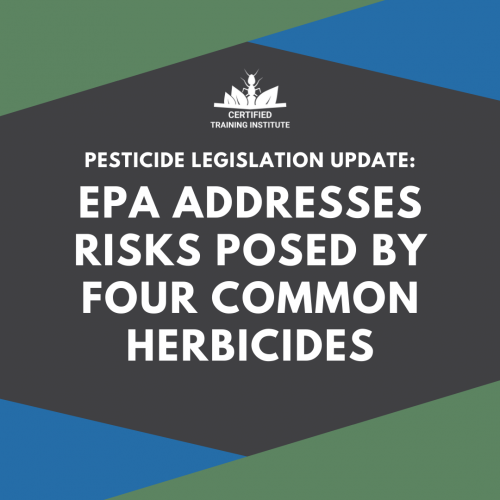Last week, to address ecological risks, the Environmental Protection Agency (EPA) released interim decisions (ID) for three Pyridines and Pyrimidines herbicides: clopyralid, dithiopyr, and triclopyr. Picloram, another similar herbicide, currently has a proposed interim decision (PID).
If you don’t feel like reading the entire report, read on to view a summarized (and simplified) description of what these decisions mean for applicators.
New Decisions Bring Updated Label Language & Restrictions
Pyridines and Pyrimidines are a class of herbicides used to control broadleaf weeds, woody brush, and aquatic plants in both agricultural and non-agricultural settings. Agricultural use sites include grains, fruits, vegetables and other crops. Non-agricultural use sites include turf, industrial areas, and roadsides.
The EPA is still working to address compost contamination concerns connected to these herbicides. In the meantime, they are requiring the following measures while the IDs and PIDs are under registration review:
Clopyralid and Picloram:
- Prohibit the transport of treated plant matter and manure from animals that recently grazed in treated areas for off site composting for a period of time until residues have adequately declined.
- A clean-out period of at least 3 days for animals fed with treated plant materials.
- Removal of use on residential turf language from all labels (clopyralid only).
- For pasture and turf sites: applicators must notify landowners/operators of compost restrictions. Applicators must keep records of the notification for two years.
- Updated compost pictogram on pesticide labels showing users when not to compost materials.
- Registrants to participate in a stewardship program and provide educational outreach for those affected by herbicide residues in compost.
Triclopyr and Fluroxypyr:
- Prohibit the use of treated plant materials or manure from animals that have grazed or consumed forage from treated areas for composting until 30 days after application.
- A clean-out period of at least 3 days for animals fed with treated plant materials.The IDs for the three herbicides mentioned above finalize enforceable mitigation measures to address spray drift risks as well as potential residues in compost.
The compost mitigation measures also include updated label language that focuses on:
Clopyralid and Triclopyr
- Reducing compost contamination by prohibiting off-site composting of treated plant matter and manure from grazing animals until residues have adequately declined
Clopyralid Only
- Requiring pasture and turf applicators to notify the property owners/operators of the compost prohibition, and for the applicator to keep a record of this notification for two years
- Requiring registrants to participate in a stewardship program and provide educational outreach for those affected by herbicide residues in compost
- Removal of residential use on turf language from all labels
Picloram Public Comments
The PID for picloram, which proposes mitigation similar to the mitigation measures in the clopyralid ID, is currently open for public comment. Interim registration review decisions impose risk mitigation measures necessary to protect the environment pending additional assessments including an endangered species assessment. After reviewing and considering the public comments received on the proposed interim decision for picloram, the EPA will proceed with the registration review process and issue the picloram ID.
Potential Environmental & Human Health Risks
The EPA only lists negative ecological effects as a result of Pyridines and Pyrimidines herbicides on their website. They say the ecological risks are primarily non-target terrestrial plants through spray drift and runoff. Certain herbicides in the pyridine/pyrimidine class can persist in treated plant materials, and when treated materials are recycled into compost, can cause harm to plants in gardens and ornamental plots where the compost is applied. Pathways into compost include residues in treated turf clippings, hay from treated pastures, and manure from animals that have grazed in treated areas.
Although the EPA says “there are no human health risks of concern for this class of herbicides,” the Oregon Health Authority (OHA) has different data.
According to OHA, continued exposure to drinking water that has a level of picloram above the legal limit of 500 parts per billion can cause diarrhea, weight loss, liver damage, and damage to the central nervous system.
If you have data or experience that agrees with OHA, be sure to submit your public comment on picloram here. And if you currently use any of the other three herbicides mentioned earlier, be sure to review and follow the new EPA guidelines.
